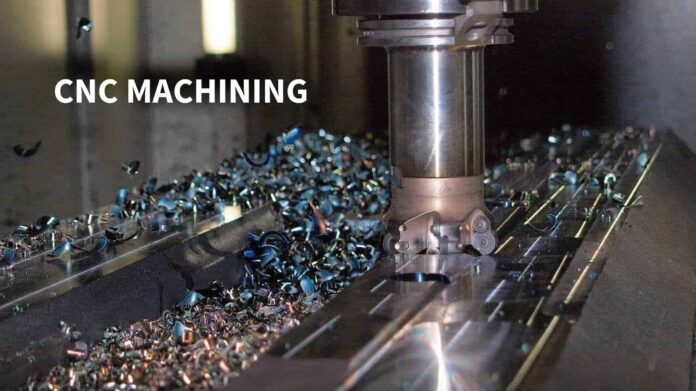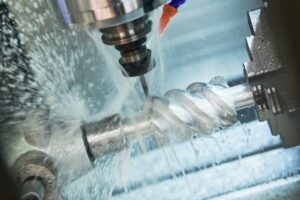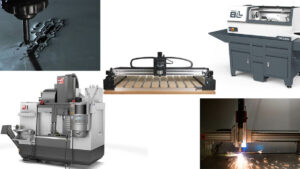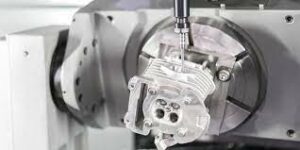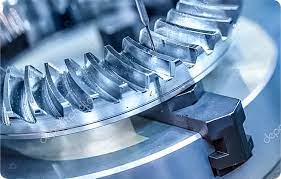Guide About CNC Precision Machining will be described in this article. Have you ever pondered how machinists create those large, heavy engine parts and tools made of aluminum? They most certainly weren’t crafted by hand or made in a furnace. These components are produced using a technique known as CNC precision milling. If you’re unfamiliar with the manufacturing industry, CNC precision machining is a manufacturing technique that uses computer programs to create any product to precise specifications. The method, various pieces of equipment used, its applications, as well as the various programming and processing required, will all be defined in this article. You should continue reading if you want to learn more about this manufacturing procedure.
What is CNC Precision Machining Complete Guide In 2023
In this article, you can know about What is CNC Precision Machining Complete Guide In 2023 here are the details below;
What is CNC Precision Machining?
Applications for CNC precision machining II Types of Precision CNC Machining Equipment III High Precision CNC Machining Advantages IV Sixth Step: How to Perform Precision Machining Seven FAQs for RapidDirect, The Precision CNC Machining Company You’ve Been Looking For
CNC Precision Machining: What Is It?
Here is the answer to the query, “What Is Precise Machining?” Similar to what the term suggests, CNC precision machining entails shaping raw materials into finished products by removing extras in accordance with a CAD/CAM blueprint. What’s more, machinists apply this technique to a variety of materials and manufacturing methods.
The design for any product must be created using CAD or CAM software before it can be manufactured using precision CNC machining. To effectively replicate the product, a precise machining process must follow the highly detailed 3D outlines created by these programs.
Any product with parts, whether it be toys, medical equipment, cars, or space shuttles, requires precision machining. The method makes use of operations like cutting, milling, turning, and electrical discharge machining using Computer Numerical Control (CNC) equipment to produce the final product.
Although an experienced machinist must supervise the process, a machine handles the majority of the work automatically. The design is constructed using computer-aided design (CAD) software, which is then converted into manufacturing specifications for the machine using computer-aided manufacturing (CAM) software. The instruction is codified into information that the machine can comprehend by a final post-processor software. The manufacturing process is then initiated by the machinists loading the order into the CNC machinery.
Tolerance of Precision Machining
Despite being extremely exact, precision CNC machining tools cannot precisely duplicate a product’s dimensions as they appear in the CAD blueprint. Tolerances are therefore used by machinists.
The deviation in a part’s dimension that is within tolerance and is considered acceptable by industry norms. Dimensional precision is a term that describes it. For all types of accurate CNC machining, there is no set tolerance. The manufacturing procedure determines how strict of a tolerance to use. A tolerance value’s number of decimal digits reveals how exact the measurement is.
There are different types of tolerance measurement systems. For example:
Measuring unilateral tolerance: Only one side of the nominal number may deviate in this kind of tolerance measurement. This means that if a bearing’s nominal shaft size is 20mm, a shaft larger than that won’t slide in. Machinists only permit a tiny amount of deviation for such a shaft.
Tolerance Limits: When the tolerance number is set within a range, this occurs. A limit tolerance would be, for instance, if the nominal value of the shaft was 15mm and the margin was between 15 and 15.5mm.
limits on both sides: The nominal value may deviate on either side of this sort of tolerance. Typically, it is written as a +/- number. To be more specific, if a component has a measurement of 25 mm and a tolerance of +/- 0.05 mm, it indicates that the value may fall anywhere between 24.95 mm and 25.05 mm.
It’s crucial to understand when to make parts with tighter tolerances. Although the entire part need not adhere to strict tolerances, the crucial structural elements, such as those that slot into other components, should only deviate slightly from the nominal value because any more could compromise the part’s integrity.
Tolerances are crucial for accurate machining processes because they speed up turnaround and cut down on production costs. Despite how crucial they are, getting them correctly takes a lot of skill and patience. CNC tools typically have a tolerance of 0.005 inches. Our 5-axis CNC tools at RapidDirect have a tolerance of up to 0.002.” To satisfy the conditions of our customers, we provide a variety of tolerances. For CNC machining metals, our normal tolerances adhere to DIN-2768-1-fine, while for CNC machining plastics, it adheres to DIN-2768-1-medium.
Types of Precision CNC Machining Equipment
The various procedures involved in CNC precision machining necessitate the use of various pieces of equipment. Sometimes only the start and stop of the procedure are required by the machinist because these tools are mounted on a single machine. In other circumstances, the tools must be mounted on various machines, and the machinist must transfer the product or raw material from one machine to the next. For instance, equipment used in CNC precision milling consists of:
CNC Milling Equipment
The precise machining procedure known as milling includes removing extra material from a workpiece with rotary cutters. There are various mill kinds involved. End mills, chamfer mills, and spiral mills are a few examples of these mills. Additionally, there are manual mills, plain mills, universal mills, and universal mills among the CNC-enabled mills. These devices are either horizontally or vertically oriented.
CNC Turning Equipment
Turning is a type of precision CNC machining in which the object is rotated alongside a single-point cutting tool. Lathes, including turret lathes, engine lathes, and engine-purpose lathes, are the most widely used instruments for turning operations. There is also straight turning, taper turning, external grooves, and threading tools.
CNC drilling equipment
CNC Equipment for Drilling: Drilling is an exact machining procedure that makes cylindrical holes in raw materials or workpieces using rotating multi-point drill bits. Additionally, because of how the drill bits are made, chips from the workpiece can fall away from them, keeping the drilled openings tidy.
CNC Electric Discharge Mining Equipment
Spotting exercises (for producing shallow or pilot holes), peck drills (for decreasing the amount of chips on the workpiece), screw machine drills (for producing holes without a pilot hole), & chucking reamers are a few examples of popular drill bits used in CNC machining operations. (for enlarging previously produced holes). Additionally, there are drill presses, which are drill bits designed specifically for a given drilling job.
CNC Precision Machining Applications
The setup consists of an electrode for the tool (tool) and an electrode for the workpiece (workpiece), which are divided by a dielectric fluid and electrically charged. Burning, die lowering, spark machining, spark erosion, and wire erosion are additional names for the procedure.
Medical Industry
Due to its numerous applications, low costs, and quick processes, precision machining is steadily gaining ground in the manufacturing industry. The following sectors make use of the precise machining process: Industry of Medicine As a result of this rapid evolution, new technology is becoming necessary. They need to produce large quantities of used tools in addition to new ones. This apparatus is made using precision CNC machining. These include, for instance, implants, MRI machines, safe enclosures, orthotic devices, study tools, etc.
Automotive Industry
Automobile manufacturers must create prototypes of these components before adding them to the production line because they are constantly coming up with new innovations to incorporate into their most recent car models. These prototypes are made to exacting specs using CNC precision machining. The technology also produces components for various other forms of transportation, including vehicles for delivery and shipping.
Aerospace Industry
Aerospace vehicles, which range from passenger aircraft to space shuttles, require extremely precise devices because even a small mistake could result in serious harm to the various aeronautical vehicles. Landing gear ports, bushings, manifolds, airfoils, and other components are made in this business using the CNC precision machining technique.
Military and Defense Industry
With various countries developing unique designs for new ammunition and defense systems, CNC has never been more important. All of these designs are brought to life using different materials and techniques through the precise machining process. Devices made for this business include, for instance, components for airplanes, vehicles, communications, and weapons. There are many benefits to using these extremely precise tools in your manufacturing process. Several are:
Reduced cost of production
When it comes to cost, CNC machining is the best option, particularly if you need to produce a few to one hundred parts. Compared to the price of injection molding, the process needs less money up front. (due to the expenses of creating the mold).
Increased speed
In comparison to injection molding, CNC machines offer a greater rate of speed. CNC machining can produce components in a matter of weeks, unlike injection molding, which may require months to create the mold and guarantee the parts are within tolerance.
Allows for Rapid and cost-effective prototyping
Your prototype manufacturing is even more efficient with CNC machining services. This is so you don’t have to spend a lot of money on samples because CNC can work with many inexpensive materials. Of course, the entire manufacturing process is sped up even more when the prototypes are produced more quickly. Prototypes that are delivered by RapidDirect are up to production and quality standards.
How to Carry out precision Machining
Materials
A range of materials can be worked with precision CNC machining. If you ask for it, RapidDirect will provide you with material approval (SGS, RoHS, etc.). We give certification for a variety of metals and plastics, some of which are listed below:
Metals
- Aluminium (Aluminum 6061, Aluminum 6061-T651, Aluminum 606, etc.)
- Steel is stainless (201, 301, 303, 304, 316, etc)
- Steel (1008, 1018, 1020, etc)
- Brass (280, 260, 2680, etc)
- Copper
- Bronze
- metals made of titanium for CNC precision cutting
Plastics
- ABS
- PC
- PMMA
- POM
- PA
Just a few of the elements used in precision CNC machining are listed above. For your custom prototyping and production requirements, RapidDirect offers thousands of materials. To see a complete list of our materials, submit your design for a quick estimate and get started on your project right away!
Programming
Every piece of data that is uploaded is private and safe. Get a Quote Immediately Programming The machines must first be programmed to make the precise machining process operate smoothly and error-free before it can start. Here is the procedure to take to accomplish this: A CNC-compatible file format, such as STEP or IGES, is used to send the 2D vector or 3D solid blueprint created by computer-aided design (CAD) software for the manufactured product.
The digital programming code needed to operate the tooling and create the specifically designed component is then produced by the computer-aided manufacturing software (CAM). The G-code and the M-code are the two most common computer codes. The Geometric code, also known as the G-code, is more widely used. It directs the machine’s movement in terms of when, where, and how. The code known as the M-code is used to control the machine’s auxiliary tasks.
Processing
The process of processing the raw material to make it precisely match the requirements for the final product begins after the machine has been programmed. The final product is produced using a variety of methods, depending on the product. Examples comprise:
- CNC Milling (a).
- CNC Turning
- Drilling using CNC
Surface Finishing
To further strengthen and enhance the final product, this entails plating the surface with various materials. We use a variety of finishing methods at RapidDirect, including anodizing, bead blasting, electroplating, powder coating, etc.
RapidDirect: The Precision CNC Machining company you’ve been searching for
Unquestionably, CNC precision machining is the most efficient method for producing your custom components. Along with saving you money, it also requires very little effort and leaves little room for error. Include this manufacturing method in your current production.
Your CAD blueprints are brought to life by RapidDirect in the best possible manner. With our extensive range of engineering expertise and methodology, we guarantee strong manufacturing capabilities. Our ability to produce your CNC designs, whether they be one-off custom prototypes or parts that require up to months of production, is made possible by our 3, 4, and 5-axis CNC machines and a broad range of auxiliaries.
Our clients receive the best technical assistance available. If you’d prefer, we can send the product in two separate sets. Before we start complete production, the first set will be sent to you for approval. We offer you the proper assurance that your product will fit and function exactly as intended by shipping it with the part dimensions after production is complete. Additionally, we include material certification with each of our goods so that you can learn more about the material’s properties.
Deliver High quality parts
In addition to all of these characteristics, our prices set us apart from the competition. We at RapidDirect assist you in reducing production expenses by offering a price that is 30% less than the industry average. We furnish you with finished parts of the highest quality made with the most recent advancements in CNC technology, just as stated in our certified ISO 9001:2015 QMS standards.
You won’t have to wait forever to receive your quote from RapidDirect. Once your CAD file has been uploaded to our website, you will receive an online quotation that will give you access to an actual design in less than a minute. The letters back and forth are avoided thanks to this. You also appreciate the plan for Manufacturing function, which indicates whether or not your plan is suitable for manufacture. Start your project right away by uploading your design assets!
FAQs – Get an Instant Quote
CNC Precision Machining: What Is It?
Simply shaping a raw substance or workpiece to meet precise dimensions constitutes CNC precision machining. In order to do this, models created from CAD and CAM designs are used.
What does a CNC machine cost?
The price of a CNC mill is based on the size and scope of tasks it can perform. It costs anywhere between $50,000 and $170,000.
How can I tell if the accuracy of my CNC machine?
Positional precision is a term used to describe how accurate a CNC machine is. It is calculated by setting the machine to move to a specific number and recording any deviation from that value. The statistical average value of the deviations is determined after several measurements are taken, and this number represents the machine’s positional accuracy. The typical number for the majority of CNC machines is 0.02mm. Your machine is probably not accurate if your number falls outside of that range.

